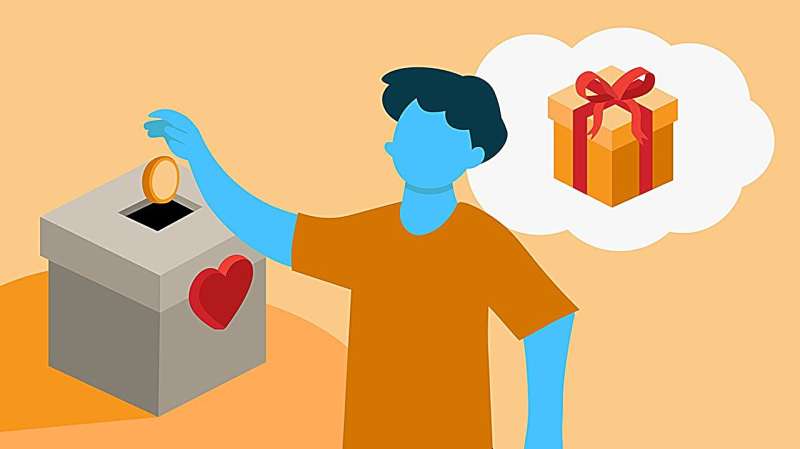This article has been reviewed according to Science X's editorial process and policies. Editors have highlighted the following attributes while ensuring the content's credibility:
fact-checked
peer-reviewed publication
trusted source
proofread
Promoting thank-you gifts can boost charitable donations

Americans gave nearly a half-trillion dollars to charities in 2022, according to the National Philanthropic Trust, with nearly two-thirds of that total coming from individuals.
What spurred those millions of people to do all that giving? Goodwill and passion for one's particular favorite cause, to be sure—but for many, that gift card, coffee mug or blanket might have helped seal the deal.
In three experiments and a field study involving alumni donors at a large university, Y. Rin Yoon, a doctoral student in marketing, and Kaitlin Woolley, associate professor of marketing in the Cornell SC Johnson College of Business, found that for some charitable donors, that extra incentive is an important lever for opening pocketbooks, and advertising it prominently can help.
"We weren't sure how our study results would play out, and we thought there could be a backfire effect: Maybe if you're so motivated to donate to a refugee cause, getting a small incentive like a coffee mug might cheapen the motivation to help," Woolley said. "We wondered if charities might be smart to downplay these incentives, but we actually didn't find that in the data. We found that, if anything, charities might be leaving money on the table by having these incentives and not highlighting them."
Woolley and Yoon are co-authors of "The Interactive Effect of Incentive Salience and Prosocial Motivation on Prosocial Behavior," which was published March 13 in Psychological Science.
Most of the largest charities in the U.S. provide incentives to bring in donors, Yoon said, but many choose to downplay these incentives.
"In many cases, we didn't find these incentives on the main page of the charity or the primary donation page," Yoon said. "So we wondered: Does advertising these incentives actually undermine prosocial behavior? Or are charities missing out on opportunities to maximize their donation rate by not prominently displaying these incentives?"
For their research, Woolley and Yoon first gathered data from the 100 largest charities in the U.S. and found that 71 offered incentives for donating but only four advertised the incentive on their homepage. Another 10 advertised it on their primary donation page.
In Study 1, the researchers assigned more than 800 participants to one of four experiment conditions, manipulating both incentive visibility (high or low) and the type of charity, evoking more prosocial motivation (helping war refugees) or less (helping a local community theater) on a simulated charity website.
In other experiments, the researchers designed fundraising events where participants donated through simple actions like typing or clicking. In Study 2, participants were tasked with alternately pressing the A and L keys on their keyboard for three minutes, to move an icon from left to right along a horizontal path on the screen. For each pair of keypresses, sponsors would donate $0.01 to the participants' assigned charity; participants themselves would receive $0.0001 per pair of keypresses.
"We wanted to mirror someone giving of their time and effort, beyond just giving money," Woolley said.
In Study 3, the researchers measured, rather than manipulated, participants' motivation to support a cause. Participants were asked to click their mouse rapidly for 90 seconds; the more they clicked, the more money went to the nonprofit organization. Again, participants also earned a small fraction for themselves for each click.
In all three studies, the researchers found that increasing the visibility of the incentive also increased the likelihood of giving when prosocial motivation was low, but did not discourage giving when motivation was high. That was a bit of a surprise, Yoon said.
"We didn't see the backfiring effect in these studies," she said. "For highly motivated givers, when we give them small incentives or gifts, we imagined they would say, "I'm not donating because of this." But we were surprised to find that these people kept themselves grounded to the cause that actually matters to them."
They found similar results in the real world. In their field experiment, more than 22,000 university donors with varying levels of motivation to donate received a thank-you card or a card and a small gift (a packet of seeds) in the mail as an incentive to donate.
"For that one, we thought, here are people who are giving a lot to the university, there's high motivation, so we wondered, would this small seed packet cheapen their donation?" Woolley said. "The alumni affairs officers were also concerned about that, but the fact that we found no undermining there was really surprising."
More information: Y. Rin Yoon et al, The Interactive Effect of Incentive Salience and Prosocial Motivation on Prosocial Behavior, Psychological Science (2024). DOI: 10.1177/09567976241234560
Journal information: Psychological Science
Provided by Cornell University


















